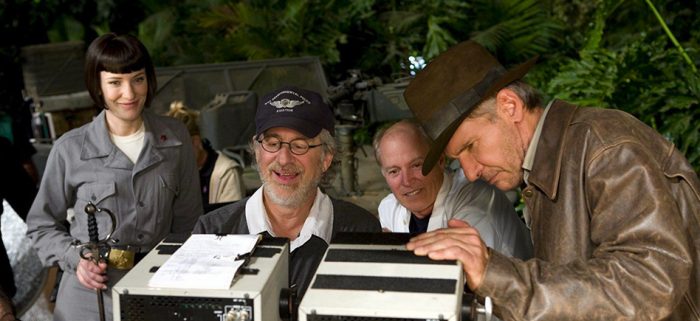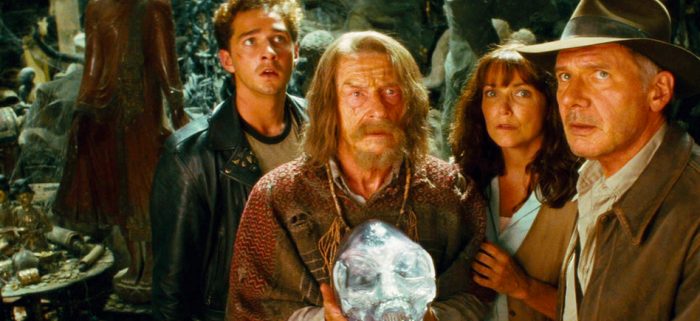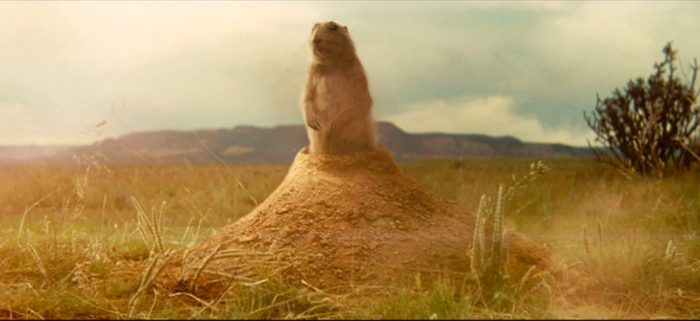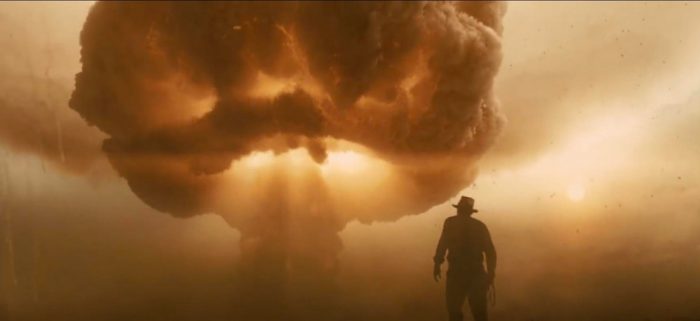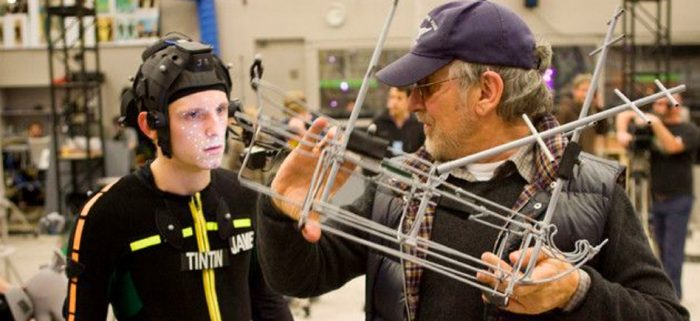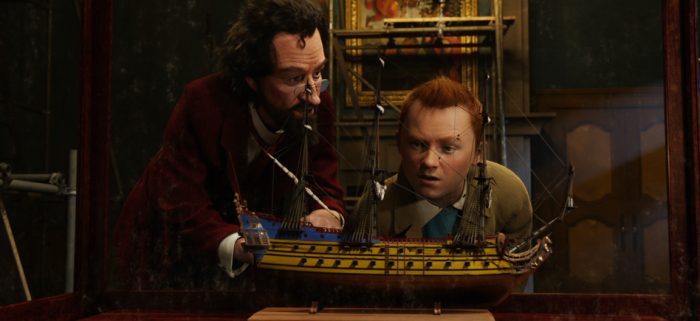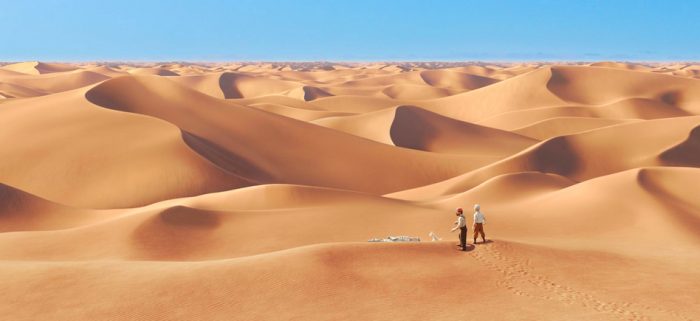21st Century Spielberg Podcast: Steven Spielberg Returned To The Great Adventure With 'Indiana Jones And The Kingdom Of The Crystal Skull' and 'The Adventures Of Tintin'
(Welcome to 21st Century Spielberg, an ongoing column and podcast that examines the challenging, sometimes misunderstood 21st century filmography of one of our greatest living filmmakers, Steven Spielberg. In this edition: Indiana Jones and the Kingdom of the Crystal Skull and The Adventures of Tintin.)
May, 1977: George Lucas had fled to Hawaii. Star Wars, Lucas' new film, had just arrived in theaters and would eventually be on its way to becoming one of the first blockbusters – something no one, including Lucas, could've predicted. Worried about competing with Smokey and the Bandit, 20th Century Fox dropped Star Wars into fewer than 32 theaters just before Memorial Day. Uncertainty hung in the air. While visiting his close friend Steven Spielberg on the set of Spielberg's Close Encounters of the Third Kind, Lucas bemoaned that he was all-but-sure Close Encounters would be the bigger money maker. But his friend disagreed. Spielberg thought Star Wars would win at the box office, and Lucas turned this friendly support into a wager: the filmmakers would trade 2.5% of the profit on each other's films.
Star Wars was the bigger hit. To this day, Steven Spielberg still receives 2.5% of the profits from the film. But in May of '77, Lucas was still nervous. He wanted to get away from the stress of it all, and so off to Hawaii he went, inviting Spielberg along. And now the filmmaking friends were together on a beach – Lucas to hide from Star Wars, Spielberg to take a vacation from Close Encounters (the film would not arrive in theaters until November of that year). Ever the workaholic, Spielberg was already thinking ahead, hoping to make a dream project: a James Bond film. Spielberg had already approached Bond producer and rights holder Albert R. Broccoli about the idea once before – and been denied. Now, Spielberg told Lucas he was going to try again. Not missing a beat, Lucas replied: "I've got something better than that. It's called Raiders of the Lost Ark."
Part 4: The Return of the Great Adventure – Indiana Jones and the Kingdom of the Crystal Skull and The Adventures of Tintin
MacGuffins, Saucermen From Mars, and Cities of the Gods
It's easy to think of the Indiana Jones franchise as Steven Spielberg's baby. But the idea for the series sprung forth from the mind of George Lucas, and was practically given to Spielberg by Lucas as a gift on that Hawaiian beach back in 1977. Say what you want about Steven Spielberg, but he's nothing if not loyal to his friends.
"I'm very obedient to the stories that George writes," Spielberg said. And so he was. So obedient, in fact, that he was willing to ignore his gut feeling and agree to a questionable Lucas idea for the fourth Indiana Jones film: aliens. Well, okay, they're not technically aliens. In all the official documentation for Indiana Jones and the Kingdom of the Crystal Skull, the creatures glimpsed at the end of the film – owners of the crystal skull – are "interdimensional beings." But their design practically screams "alien." They could even be distant cousins of the E.T.'s that popped-up in Spielberg's Close Encounters.
Spielberg was not fond of the idea. But Indy was just as much Lucas' baby as it was Spielberg's, and he relented. "I'll fight things I don't believe in, but ultimately, if George wants to bring interdimensional beings into Crystal Skull, I will do the best job I possibly can to acquit his idea and make him proud," the filmmaker said. Besides, Lucas refused to admit defeat.
When crafting an Indiana Jones story, the first thing George Lucas looks for is the MacGuffin – the artifact that Indy is chasing, be it the Ark of the Covenant, Sankara Stones, or the Holy Grail. When it came time to come up with Indy 4, Lucas struggled with what MacGuffin Dr. Jones would be chasing around the globe this time.
"The Ark of the Covenant was perfect," Lucas said. "The Sankara Stones were way too esoteric. The Holy Grail was sort of feeble — but, at the same time, we put the father in there to cover for it. I mean, the whole reason it became a dad movie was because I was scared to hell that there wasn't enough power behind the Holy Grail to carry a movie. So we kept pushing to have it function on some level — and to make it function for a father and a son. To make it that kind of a movie was the big risk and the big challenge, but also the thing that pulled it out of the fire. So, at the end of it, I was like, No more of these, baby. We're done. I can't think of anything else. We barely got by on the last one!"
Eventually, Lucas came up with something he thought would work: aliens. One screenwriter after another was brought in to make Lucas' ideas a reality, but no one was buying it. "This went on for 15 years," Lucas said. "And finally we got to a point where everybody said, 'Look, we're not doing that movie.' And I said, 'Well, look, I can't think of another MacGuffin. This is it. This works. I know this works.' And then we stopped."
It would be series star Harrison Ford who got the ball rolling again. He wanted another Indy adventure, and he wouldn't do it without Spielberg and Lucas. And Lucas wouldn't do it without his aliens. "I won't do it unless we can have that MacGuffin," Lucas told Ford. "Without the MacGuffin, I will not go near this thing." There was no way around it: it had to be aliens. Or...uh...interdimensional beings, rather.
Before the shooting script, credited to David Koepp from a story by Lucas and Jeff Nathanson, a potential Indy 4 had gone through several different incarnations. There was a script from Jeb Stuart called Indiana Jones and the Saucermen from Mars. And then there was Frank Darabont's Indiana Jones and the City of the Gods. Darabont's script excited Spielberg. He even went as far as to call it "The best script he'd read since Raiders of the Lost Ark," at least according to Darabont. This was the movie he wanted to make. But it didn't happen. Once again, Lucas had the final say, and Lucas expressed dissatisfaction with Darabont's work, and Darabont was soon out – although many of his ideas would linger. To this day, a "what if" hangs over Crystal Skull. What if Spielberg had overruled Lucas and stuck with Darabont's script? Would we have been spared a "disaster"?
This questioning hinges on the acceptance that Indiana Jones and the Kingdom of the Crystal Skull *is* a disaster. But that's not fair. There's a lot to love in Crystal Skull. It's another whip-cracking adventure loaded with Spielbergian set-pieces. Harrison Ford is by no means phoning it in, and slips back into Indy mode easily, wearing the character like a comfy sweater. Cate Blanchett is delightfully hammy as a psychic Russian with a Louise Brooks haircut. Karen Allen is back as Marion Ravenwood, unquestionably the best of the Indy female leads. And after the one-two 9/11-themed punch of War of the Worlds and Munich, Crystal Skull is Spielberg having fun again. And "fun" seems to be the one thing the general public wants from Spielberg's movies.
So what went wrong?
It's Not The Years, Honey – It's The Mileage
Indiana Jones and the Kingdom of the Crystal Skull isn't really about aliens. It's about family. Family is an important thing for Spielberg, who has seven kids. And it's also about getting old. Crystal Skull came about around the time Spielberg was about to become a grandfather for the first time (he has a total of four grandchildren now). There was no denying it: Steven Spielberg was getting old, and Indiana Jones was getting old right along with him. The legendary director was 62 when Crystal Skull hit theaters and star Harrison Ford was 66. Those aren't ancient ages, but they're not what would be categorized as "young," either.
And aging is built into Crystal Skull from top to bottom. There's a constant reminder that Indy is no longer the youthful adventurer he once was. His hair has grayed – Ford refused to dye his hair for the role – and the script is constantly pointing out Indy's advancing years ("What are you, like, 80?" a character asks him at one point).
Time has claimed not just Indy's youth but also his friends and family. His father, memorably played by Sean Connery in Last Crusade, is revealed to have died in between films (Connery is still alive, but had no interest in returning for what would've been a minor cameo in Crystal Skull). Ditto Indy's good friend Marcus Brody (Brody actor Denholm Elliott died in 1992).
"We seem to have reached the age where life stops giving us things and starts taking them away," the Dean (Jim Broadbent) of the college where Dr. Jones teaches mournfully observes.
After all his globe-trotting adventures, after all his encounters with the supernatural, after all his tussles with beautiful women – some of whom turned out to be Nazi spies – Indiana Jones is ultimately alone. As Crystal Skull opens, Indy and his close friend George "Mac" McHale (Ray Winstone) have been kidnapped by evil Russians who want to use Indy to help locate something hidden at the fabled Area 51. The escapade ends with the location of a mummified corpse of an alien retrieved from Roswell (it also ends with Indy surviving a nuclear blast while hiding inside a refrigerator, but we'll get to that later).
The dust-up with the Russians also has Indy discovering his best friend Mac is a traitor, willing to sell him out to the Ruskies. And now the FBI suddenly thinks his friendship with the treacherous Mac indicates that Indy could be a secret Soviet spy as well. It's the 1950s and being labeled a communist costs Indy his job. Friendless, without a family, Indy has no one close to turn to.
Enter Mutt Williams.
Oh, Mutt Williams, you greaser goofball, you. So much has been said – almost all of it overwhelmingly negative – about poor Mutt Williams, the long-lost son of Indiana Jones. While the basic framework of Darabont's City of the Gods script made it into Crystal Skull, Mutt Williams does not appear. Indy has no son in the alternate script, and he doesn't even learn that Mutt is his kid until midway through Crystal Skull.
As played by Shia LaBeouf, an actor whose star was on the rise due to his appearance in the Spielberg-produced Transformers, Mutt does not deserve the vitriol he received from fans. Why the backlash? There's a two-point explanation for this. One is that LaBeouf was being pushed as the Next Big Thing, and many filmgoers weren't buying it. Another is that there's an immediate assumption that the younger LaBeouf was being thrust upon audiences to take over the franchise. The film even teases this for a moment by having a final scene where Mutt longingly stares down at Indy's hat and considers putting it on his own head – before Indy comes back and snatches it away. And oh yeah, there's also a dumb scene where Mutt swings through the jungle like Tarzan, accompanied by CGI monkeys.
But the years have been kinder to Mutt Williams. The character is not the abomination many made him out to be. What makes the character ultimately work is LaBeouf's performance, which is quite funny. The false tough-guy bravado he brings to the role is not meant to be taken seriously, and indeed, all his attempts to seem like a badass are met with rolled-eyes by Indy. Ford and LaBeouf have easy-going chemistry with one another, and while the movie never sells us on their father-son relationship, they play off each other nicely. And relationships are a big part of Crystal Skull.
The plot involves Indy and Mutt running all over the world trying to find family friend Harold Oxley (John Hurt), who has been driven mad by exposure to a crystal skull. They eventually find the skull, which isn't just a piece of art – it's a real skull that came from the head of an alien. The Russians, lead by Soviet agent Irina Spalko (Cate Blanchett), are also looking for the skull, and soon, everyone comes together, including Marion Ravenwood, Mutt's mother, and Indy's long-lost love. Bringing Karen Allen back as Marion is a great idea, and while Crystal Skull doesn't give her much to do, Allen is as charming and affable as ever.
After facing off with giant killer ants, various waterfalls, and other boobytraps, the characters all convene at the Lost City of Akator in the Amazon jungle, where they discover those damn interdimensional beings. As is customary, the unquenchable thirst for discovery leads to the demise of Indy's nemesis as Spalko has her head melted by a frowning CGI alien returned to life. It's often painfully silly. But not without its charms. And in the end, Indy goes from a loner to a family man. He gets married, he has a son, and he even has a surrogate father in the form of Oxley.
"In some ways, this quest is really about forging and re-creating a family," LaBeouf said. "First with Indiana, then with the others they meet, their unit becomes stronger as all this insanity happens – you know, each punch is bringing them closer together."
Attack of the Digital Prairie Dogs
The general consensus seems to be that everyone and their mother hates Crystal Skull, but the movie was by no means a disaster. Many of the reviews were positive, and the global box office haul was $790 million, making it the biggest hit in the franchise (not adjusted for inflation). But over the years, Crystal Skull has become the bastard stepchild of the series; the film everyone wants to forget about. When artists are brought in to officially create new Indiana Jones prints to be sold to fans, no one wants to include Crystal Skull. And when it comes to the impending Indiana Jones 5, which is no longer in Spielberg's hands, the hope surrounding the film is that it will "fix" what Crystal Skull broke. That it'll send Indy out with a worthy adventure rather than...this.
Is the disdain justified? Is Crystal Skull really all that bad? Well, like most things, the answer isn't a simple yes or no. It's complicated. And complications are a big part of the problem here: there's too much shit going on. The Indy series was always about big, bold adventure and big, bold action set-pieces. But there was a grounded charm to it all. Sure, Indy was a pulp hero plucked from old movie serials, and he was often encountering full-blown supernatural happenings. But everything in the first three Indiana Jones films felt, well, real, in a way that Crystal Skull can't match.
Part of that has to do with how movies are made these days. The first three Indy films were before the age of non-stop CGI. Spielberg and company had to rely on practical effects – models, matte paintings, make-up, and other in-camera trickery. But Crystal Skull is a film of the 21st century, and while Spielberg still has a soft spot for practicality, he's not above letting the digital encroach on the physical. As a result, we get scenes where Indy and company drive through a jungle so glaringly fake it might as well be a cartoon. In fact, the first shot of the film is full-blown cartoonish, with the Paramount Pictures mountain logo turning into a prairie dog hole, complete with a digital prairie dog popping his little animated face out. It looks horrendous, and immediately starts things off on a sour note. Really, Spielberg? you think, Is this really how you want to start your movie? Spielberg adds insult to injury by bringing a whole pack of digital prairie dogs back for a later sight gag.
Digital ants come crawling, digital aliens show up at the end, digital light explodes out of Cate Blanchett's head. It's all so depressingly fake. Gone is the wonder, the awe-shucks enthusiasm that prevails through the Indiana Jones films that came before. Nothing here feels as if it exists in anything resembling the real world. Before production began, Spielberg boasted that the film would follow in the franchise's footsteps and use as many practical effects as possible. But as filming began, that changed. Practical effects weren't, well, practical enough. The cacophony of action going on here would be forgivable if it weren't so unnatural looking.
Not helping matters is the cinematography courtesy of Spielberg's go-to DOP Janusz Kaminski. Kaminski's look is a big part of Spielberg's 21st-century filmography, full of bright white lights that often go fuzzy around the edges. Through Kaminski's lens, the worlds Spielberg creates often look harsh and sterile. And for the most part, it works. But not for Indiana Jones.
Douglas Slocombe shot the first three Indy films, but by the time Crystal Skull came around, he was 94 and retired. In interviews, Spielberg insisted he made Kaminski watch the first three Indiana Jones films in order to capture Slocombe's style and port it over to Crystal Skull. "I needed to show them to Janusz," the filmmaker said, "because I didn't want Janusz to modernize and bring us into the 21st century. I still wanted the film to have a lighting style not dissimilar to the work Doug Slocombe had achieved, which meant that both Janusz and I had to swallow our pride. Janusz had to approximate another cinematographer's look, and I had to approximate this younger director's look that I thought I had moved away from after almost two decades."
That's great, in theory. But the end results don't reflect that at all. Save for shots of red lines jutting over maps to show Indy traveling from one location to the next, not a single frame here resembles anything in Raiders of the Lost Ark, Indiana Jones and the Temple of Doom, or Indiana Jones and the Last Crusade. The bright, blurry light that Kaminski specializes in effectively irradiates the magic.
Then there's Koepp's script, which is a blend of stuff Darabont wrote with ideas cobbled together from other various drafts. In short, it's a mess. There are too many villains, even though Blanchett's Soviet swordfighter is the only one who gets anything close to characterization. There's also a groan-inducing storyline about Indy's old pal Mac, who keeps changing sides every scene he's in. It's one thing to have a morally ambiguous character, it's another to have our hero constantly falling for his crap. Despite all the nefarious stuff he's done, when Mac proclaims he's a double agent and still on Indy's side, Indy swallows it. It all culminates in a truly odd climactic scene where Mac is about to be killed by the wrath of the interdimensional beings, upon which he looks at the camera and says, "I'm gonna be okay." Then he dies. Ray Winstone is a great grumbly actor, but there's nothing here for him to work with.
But while Crystal Skull fails on several levels, it succeeds in its action. Spielberg was determined to avoid the blurry, hard-to-follow action scenes that had become so prevalent at the time in the Bourne franchise. Instead, he frames it all distinctly, and we can see every beat. There's a motorcycle chase through a college campus that's a blast, and in most of the cases, we can clearly see Ford performing his own stunts, advancing age be damned.
Nuke the Fridge
If Indiana Jones and the Kingdom of the Crystal Skull is known for anything, it's known for adding "nuke the fridge" to our general pop culture lexicon. Early in the film, after escaping from Area 51, Indy ends up in a model town being used to test an atomic bomb. It's the first genuinely interesting scene in the movie, as the entire Area 51 opening is a clunky mishmash of false-starts.
Indy staggers into what he thinks is a real home only to discover a bunch of grinning mannequins. Spielberg captures all of this with an appropriately surreal touch as Indy stumbles around the facade he finds himself in, confused and a little creeped out by this simulation of suburbia. Indy goes from confused to panicked when he realizes where he is, and what's about to happen. Desperate to survive the blast, Indy uses his noggin and crawls inside a lead-lined refrigerator. It works: the bomb goes off and sends the fridge flying across the desert, but Indy survives seemingly unscathed. It's undeniably dumb, but is it really that much of a deal-breaker?
"What people really jumped at was Indy climbing into a refrigerator and getting blown into the sky by an atom-bomb blast," Spielberg said after the film came out. "Blame me. Don't blame George. That was my silly idea. People stopped saying 'jump the shark.' They now say, 'nuked the fridge.' I'm proud of that. I'm glad I was able to bring that into popular culture."
Sure, Indy's body would've probably been broken into a billion pieces as the fridge bounced up and down across the rough terrain. But so what? Indiana Jones is a franchise where both the Ark of the Covenant and the Holy Grail are very real things with magical powers. If we can accept that, it's okay to suspend our disbelief at this moment. Besides, it leads to one of the most iconic shots of the entire franchise: Indy, silhouetted against a mushroom cloud blooming into the scorched sky. Indiana Jones arriving in the atomic age. A man out of time. Even Spielberg's stumbles have the ability to lead to things of beauty.
That atomic age was key to Lucas' insistence on the alien element. "What made it perfect was the fact that the MacGuffin I wanted to use and the idea that Harrison would be 20 years older would fit," Lucas said "So that put it in the mid-50s, and the MacGuffin I was looking at was perfect for the mid-50s. I looked around and I said, 'Well, maybe we shouldn't do a 30s serial, because now we're in the 50s. What is the same kind of cheesy-entertainment action movie, what was the secret B movie, of the 50s?' So instead of doing a 30s Republic serial, we're doing a B science-fiction movie from the 50s."
For all his insistence on sci-fi B-movie influences, Lucas was also ready to admit defeat before Crystal Skull even hit movie screens. "The fans are all upset," he said. "They're always going to be upset. 'Why did he do it like this? And why didn't he do it like this?' They write their own movie, and then, if you don't do their movie, they get upset about it. So you just have to stand by for the bricks and the custard pies, because they're going to come flying your way."
Spielberg also laid Crystal Skull at the feet of fandom, albeit in a more positive manner. "I shot Indiana Jones riding a horse into the sunset because I thought that brought the curtain down on the story," Spielberg said, referring to the final shot of Last Crusade. "And in a sweet, nostalgic way, that was fine with me at the time. But there were some people who weren't fine with it – and this movie really started with the fans." In summation: Crystal Skull appears to have happened because of fan demand, not out of any sense of urgency, or artistic dream. All Hollywood films are products, but Crystal Skull feels more like a product than any Indy story before it. The posters for the first Indy film, Raiders of the Lost Ark, boldly proclaimed "The Return of the Great Adventure." But "great adventure" Crystal Skull is not. The true return of the great adventure for Spielberg in the 21st century wouldn't be an Indiana Jones movie at all.
Great Snakes!
Launched in 1929 by Belgian cartoonist Georges Remi, who went by the pen name Hergé, The Adventures of Tintin became a wildly successful series of Franco-Belgian comics. The character's popularity was more pronounced outside the U.S., but that didn't stop an animated 1990s series from playing in America first on HBO, and later, in reruns, on kid-friendly TV channel Nickelodeon.
While Tintin had been adventuring since the late 1920s, Steven Spielberg was unaware of the character until the 1980s. While reading a French review of Raiders of the Lost Ark, Spielberg noticed the critic comparing his old school adventure to Tintin and became intrigued. He sought out the comic series and, by the time he was gearing up to make his second Indy adventure, Indiana Jones and the Temple of Doom, the filmmaker managed to snap-up the film rights to Tintin as well.
But after ten years of failing to find a script he liked, Spielberg dropped the option. Yet Spielberg couldn't let Tintin go. The big kid in him was enchanted with the clean lines and colorful adventures Hergé created all those years ago. By 2001, Spielberg had the rights to a Tintin movie again. The plan was to make a live-action movie with actors donning prosthetic facial applications to better resemble their comic book counterparts. There was one Tintin character Spielberg felt he couldn't capture in live-action, though: Snowy, Tintin's ever-faithful dog companion.
As Spielberg developed his Tintin movie, Peter Jackson and his Weta Digital had become renowned for the ground-breaking work being done on the Lord of the Rings films, particularly the motion-capture performance of Andy Serkis as Gollum. Spielberg turned to Jackson and asked if he could help create a digital Snowy for the film. Jackson had what he thought was a better idea: an entirely animated movie using performance-capture. Jackson was a lifelong fan of the Tintin comics, and managed to convince Spielberg that live-action couldn't do them justice.
Using the same stage James Cameron used for Avatar, Jackson shot a twenty-minute test reel with himself as Tintin, and Serkis as Tintin's frequent companion Captain Haddock. It did the trick. Spielberg would buck (his) tradition and shoot digitally instead of his preferred 35 mm. He and Jackson would go into the Tintin business together, with Spielberg directing and Jackson producing and handling second unit material. After two years of research, development, design, pre-production, screenwriting, and casting, Spielberg and over 200 crew members would come together to construct a performance-captured, computer-generated movie. It would be exactly the type of gig Steven Spielberg was looking for. "This was the most fun I've had since E.T.," the director would later say.
Avoiding the Uncanny Valley
Spielberg didn't invent the performance-captured, digitally animated movie, but with The Adventures of Tintin, he and Peter Jackson perfected it. Compare Tintin to the Uncanny Valley horrors of similarly-made films from Robert Zemeckis: Beowulf and The Polar Express. Both of those films are visually hideous to the point of being offensive to the eye – films populated with weird, inhuman monstrosities that never look right, with dead, vacant, digital stares that appear to be seeing nothing at all.
Tintin, however, is vibrant, bursting with energy and life. The secret, as far as I can tell, lies in the design. When Zemeckis attempted his performance-capture nightmares, he and his animators worked to make the digital characters as "realistic" as possible. Spielberg and company didn't make the same mistake. The characters of Tintin move and behave like living, breathing humans – and they appear to have real weight, something that's also lacking from Zemeckis' attempts. But they're also highly stylized. "We're making them look photorealistic; the fibers of their clothing, the pores of their skin and each individual hair, "Jackson said. "They look exactly like real people—but real Hergé people." That last part is the key: by adapting Hergé's style, Spielberg, Jackson, and the animators found a way to avoid a trip to the Uncanny Valley. Everything here looks as real as it needs to. You buy into this world almost immediately."The lines of what Hergé drew were not necessarily accurate," Joe Letteri, the movie's senior visual effects supervisor, said. "He wasn't trying to draft exactly what he saw – and we wanted to maintain those exaggerated qualities in the same way that he did. A big part of the design study was to look at what he did, but then to imagine it from different points of view. And that allowed us to start building up a vocabulary of how you would construct his worlds in a wholly 3D animated realm."
Another problem Spielberg avoids: useless backstory. I can't help but think that if Tintin were being made today, in 2020, some executive somewhere would be insisting any Tintin film would have to spend a significant amount of time of initiating the uninitiated as to who the hell Tintin is, and why we're following him around. Heck, we might have even gotten one of those abysmal set-up movies – the type of IP adaptation that spends its entire runtime setting everything up, saving the good stuff for a sequel.
Spielberg and screenwriters Steven Moffat, Edgar Wright, and Joe Cornish, sidestep all of that with ease. After a quick, colorful intro in which Tintin (Jamie Bell) is introduced as a young, famous journalist, we head back to Tintin's apartment, at which point the camera pans across several framed newspapers displaying headlines from Tintin's past adventures (all of which are taken directly from the comics). This use of visual exposition is more than enough and gets the job done: we're not even ten minutes into this thing, and we already know that Tintin is a globe-trotting journalist who is known to get into crazy, wild, headline-worthy adventures.
"Tintin is an eager reporter who chases fragments of clues that suddenly blow up into these amazing, globe-trotting adventures," Spielberg said. "What makes him so intriguing is his relentless pursuit of the truth, although that always leads him down some treacherous paths. It often seems he's gotten himself into terrible trouble, but somehow, he finds a way out. From the first reading, I knew that Tintin and I were destined for some kind of collaboration."
And like that, we're off. The Adventures of Tintin never relents, never slows down. It's Spielberg's most active movie, with nearly every frame, every scene, devoted to propulsive action. As the adventure unfolds, it's easy to see why this is an animated movie: if any of this had been done in live-action, the entire cast and crew would probably end up badly injured – or dead.
Making an animated movie appears to have rejuvenated Spielberg. After attempting, and not really succeeding, to recapture some of his youthful magic with Crystal Skull, it would be Tintin that let Spielberg embrace his whiz-bang early days again. Like a kid just given the biggest, coolest, shiniest toy set in the galaxy, Spielberg runs wild, crafting huge, jaw-dropping moments where everything and anything is possible.
The work was done on a stage called a Volume, described in press materials as "a clean, white-and-grey stage featuring up to 100 cameras mounted in a grid on the ceiling, able to capture 360-degree coverage and render that data into three-dimensional space." Spielberg operated a virtual camera that was slightly bigger than a video game controller, and he was able to watch the actors interacting with the digital world they were meant to inhabit. Trying something so new could've been daunting, but Spielberg took to the challenge – with delightful results.
In this completely fantastical world, Spielberg is able to keep the camera constantly on the move. It whips, it pans, it floats, it flips. It dives beneath the waves. It sails on the high seas. It burns, and it breaks, and it smashes. Scenes are shot reflected in liquor bottles, in water bubbles. A flashback to two pirate ships battling among skyscraper-sized waves is a particular stand-out. First, the ships come sailing over desert sand dunes in the form of hallucination, before sending us back in time to watch the ships – and their respective crews – do battle. Eventually, both ships burst into flames, and their crow's nests become entangled with one another, drawing them closer at impossible angles – a pair of drunken dancers tangoing on a rolling dance floor. In The Adventures of Tintin, light bounces and shines – this is a bright, colorful world that's always inviting, even when things are getting dangerous for Tintin and his pals.
Fantasy Is Your Friend
In The Adventures of Tintin, intrepid journalist Tintin just happens to buy himself a fancy model ship at an outdoor market. What Tintin doesn't realize is that the model ship, The Unicorn, holds the secret to lost treasure, and the evil Ivan Ivanovitch Sakharine (Daniel Craig, having just as much fun going full ham as Cate Blanchett did in Crystal Skull) is after it. And so the stage is set for a globe-trotting adventure, in which Tintin and his trusty dog Snowy soon join forces with Captain Archibald Haddock (Andy Serkis), a constantly drunk sea captain who has a direct ancestral connection to The Unicorn.
One of the many refreshing things about Tintin is how human Tintin seems. Unlike Indiana Jones, he's constantly being one-upped – he gets knocked out and kidnapped before the movie really even starts. He's not a superhero, he's not unfappable, he's just a young guy obsessed with a good story. Whereas Indy makes archeologists look like ass-kickers, Tintin makes writers look like people who don't know any better and just happen to get lucky from time to time. That's not a criticism.
Bell is likable enough as Tintin, but it's the colorful characters that surround him that get to have the most fun. Serkis, adopting a Scottish brogue, is a hoot as the intoxicated Haddock, a man so addicted to the drink that when he sobers up for one scene he turns out to be useless. He has to be plied with more alcohol like Popeye chugging a can of spinach before he fights. While the film is in dire need of some female representation – there are only two female characters; one is a nervous neighbor, the other is an opera singer who exists solely to be made fun of – Tintin is an altogether welcoming film due to the friendship that blooms between Tintin and Haddock. Their relationship is slightly at odds, especially with Tintin growing frustrated with Haddock's drinking. But by the film's climax, they're thick as thieves. "How's your thirst for adventure, Captain?" Tintin asks, implying future excursions to come, which, sadly, haven't come yet.
But the real star of the show here is all that action. Freed from the limits of reality, Spielberg is able to stage slapstick action moments that sing – Snowy running over, and then under, a herd of cattle; Tintin and Haddock trying to fly a seaplane through a storm, with Haddock's alcohol-tinged breath put to good use when the plane runs out of fuel; and the real showstopper – a chase through the fictional Moroccan port of Bagghar, with Tintin riding a motorcycle like a bat out of hell while chasing after Sakharine's evil pet hawk. When comparing the unrelenting, hair-raising pace of this chase against any of the action from Crystal Skull, one finds oneself pining for more Spielberg animated movies.
"With animation, fantasy is your friend," the filmmaker said. "And the more fanciful and the more out of control the story seems to be reaching — and reaching for laughs and reaching for a real buddy movie rapport between Tintin and Haddock and reaching for a crazy series of flashbacks taking you back to the seventeenth century — I think all of these things go down more easily when the medium is an animated one and not a live-action one."
Spielberg may have failed to recapture the magic of old with Indiana Jones and the Kingdom of the Crystal Skull, but with The Adventures of Tintin, he outdoes even himself.
***
In the next edition of 21st Century Spielberg, Part 5: History Has Its Eyes On You – War Horse and Lincoln.

